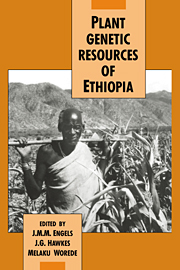Book contents
- Frontmatter
- Contents
- Contributors
- List of acronyms
- Preface
- Part I General introduction
- 1 An Ethiopian perspective on conservation and utilization of plant genetic resources
- Part II The Ethiopian centre of diversity
- Part III Germplasm collection and conservation in Ethiopia
- Part IV Evaluation and utilization of Ethiopian genetic resources
- Index
1 - An Ethiopian perspective on conservation and utilization of plant genetic resources
Published online by Cambridge University Press: 30 October 2009
- Frontmatter
- Contents
- Contributors
- List of acronyms
- Preface
- Part I General introduction
- 1 An Ethiopian perspective on conservation and utilization of plant genetic resources
- Part II The Ethiopian centre of diversity
- Part III Germplasm collection and conservation in Ethiopia
- Part IV Evaluation and utilization of Ethiopian genetic resources
- Index
Summary
Introduction
The Ethiopian region is characterized by a wide range of agro-climatic conditions, which account for the enormous diversity of biological resources that exist in the country. Probably the most important of these resources is the immense genetic diversity of the various crop plants grown in the country.
The indigenous landraces of the crop plant species, their wild relatives and the wild and weedy species which form the basis of Ethiopia's plant genetic resources, are highly prized for their potential value as sources of important variations for crop improvement programmes.
Populations of these forms of plant species also represent sources having the greatest potential for genetic diversity and can therefore serve as invaluable means to fill the gaps that still exist in the available base of genetic diversity in the world collection of many major crop species. Among the most important traits which are believed to exist in these materials are earliness, disease and pest resistance, nutritional quality, resistance to drought and other stress conditions, and characteristics especially useful in low-input agriculture.
Scientists from many parts of the world have identified highly desirable genetic characteristics in relatively few germplasm collections of various crop species and they are currently being utilized intensively in a number of breeding programmes.
- Type
- Chapter
- Information
- Plant Genetic Resources of Ethiopia , pp. 3 - 20Publisher: Cambridge University PressPrint publication year: 1991
- 8
- Cited by

